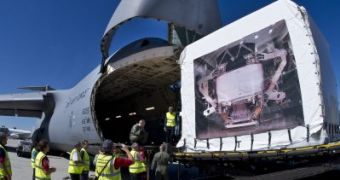The long-awaited arrival of the AMS-02 at the Kennedy Space Center in Florida took place yesterday, from the Geneva international airport, in Switzerland, under the escort of the astronauts who will fly with it on the Space Shuttle, in February 2011.
The first stage of its trip towards the International Space Station, began with a ceremony organized by the CERN – the European Organisation for Nuclear Research, while the spectrometer was loaded onto the United States Air Force Galaxy transport aircraft which brought it to Cape Canaveral.
After the arrival at the Kennedy Space Center, the AMS will be kept in a clean room for further tests, and only a few weeks later will be moved to the Space Shuttle, awaiting its last mission.
The Alpha Magnetic Spectrometer is a very big space gadget but most of all it is the result of a huge international collaboration between 56 scientific institutes from 16 different countries.
For over a decade now, Nobel Prize Laureate Samuel Ting of the Massachusetts Institute of Technology (MIT) is still the leader of the AMS-02 experiment.
The success of this long-time collaboration, which is quite a rare phenomenon, is given by the creation itself – the AMS-02.
The spectrometer is the largest scientific instrument to have ever been installed on the International Space Station and its mission is to study antimatter as well as dark matter.
If everything goes as planned, the AMS will give scientists much more information about the origin and the structure of the Universe than they have ever dreamed of.
And as it will also analyze cosmic radiation sources on stars and galaxies millions of years away from our Milky Way, physicists as well as astronomers will be eagerly waiting for the information.
The AMS-02 has a magnetic field that is 4000 times more powerful than the magnetic field of the Earth, and this jewelry of technology will examine from space, every particle that passes through it, in a program that collaborates with that of the Large Hadron Collider.
The exhaustive tests that the ESA made in its testing facilities at ESTEC, Noordwijk, The Netherlands, were beneficial for the entire program as they established that the original superconducting magnet of the AMS should be replaced by a permanent one, that will last longer.
Now, the experiment should remain active for the entire lifetime of the International Space Station without returning back to Earth.
Simonetta Di Pippo, ESA’s Human Spaceflight Director said that “The ISS is set to be utilized for scientific and exploration purposes, so it is important to count on an instrument that can remain fully active for more than a decade.”
The Space Station is the only platform possible for the installation of the AMS-02, because of stability reasons, the long-term exposure “and also because we can always refurbish the instrument if necessary,” said Di Pippo.

 14 DAY TRIAL //
14 DAY TRIAL //